| Click here to see 2010-11 work in HAITI |
Click here to see 2005 in INDONESIA |
To be updated ...
Dr. Beth Hedva’s
WORKSHOP-ON-PAPER
|
||
|
1) 2010: A Decade of Creative Reconstruction
Exercise I: Embody your Creativity 2) 2010 – 2019: Creativity—A New Cycle is Born Exercise II: Self-Ecology 3) Making Sense of the Last Decade: 2000 – 2009: Polarization, Expansion and Contraction Exercise III: Own the Shadow 4) Preparing for the Year 2012: Before and After Exercise 1V: Seed Thoughts for Meditation 5) Creative Reconstruction for Seven Generations |
||
1) 2010: A Decade of Creative Reconstruction Western Mystery Traditions blends with archetypal depth psychology to suggest that we are currently in the middle of a 20 year cycle of awakening and integrating the power of the archetypal Feminine Spirit. The archetypal feminine invites both men and women alike to become midwives to help give birth to our new world. Ancient symbol systems, like numerology and astrology offer insights into this shift in consciousness. If you are alive now, you were born to live during this time in history, a time of radical reorientation that requires us to re-invent ourselves and our world. Most important during times like these: 1) Take time to Relax, Renew and Replenish 2) Be consistent with self-ecology/self-care 3) Collaborate with others who share your dreams. The last decade tested both our imagination and resourcefulness. This next decade promises to inspire creative reconstruction of life-sustaining practices and policies in support of deep-ecology that celebrates the diversity of all life in every corner of the world. This next decade forwards a cycle of ‘Creative Reconstruction’, a time to give birth to your dreams, to nurture and nourish new opportunities, and construct life-sustaining personal practices that support you and all your relationships personally, interpersonally, socially and globally. Self-ecology is essential in the years to come. Listen to your intuition. You will receive signals through your body’s felt-sense, your emotional feelings as well as in the form of insight, dreams, visions and hunches. Also watch your thoughts and attitudes, and listen for ‘a silent whispering voice’ to guide you beyond the mind’s chatter. For example, a racing mind, or feeling frustrated is a signal to slow down and breathe. Calm enthusiasm is a sign of creativity. Also watch for synchronicities and other subtle impressions. Use subtle signals to show you when you are in or out of balance with a greater creative sense of flow. Remember to take care of yourself physically/materially, emotionally, attitudinally and spiritually. EXERCISE I Embody Your Creativity Instructions: Take a moment to review the gifts and challenges of the past decade. Identify your accomplishments, recognize and release the ‘would-have’s, should-have’s, could-have’s, if-only’s’. Your self-judgment is a reflection of your lack of self-acceptance. Use it instead as an invitation to do ‘inner-work’to gain insight, create value and personal meaning. Hint: Notice your thoughts, feelings and body sensations. These intuitive impressions are guide posts indicating when you are in or out of balance with the life that is being born through you. Action: Choose to go in the direction of your victories and fulfillment to construct a life that is in balance with your greater creative flow. This requires trusting your intuition and staying ‘grounded’ i.e. be self-responsible and accountable as you give birth to your dreams. Practice: Learn from all your experiences, and accept that the mystery of ‘why’ things may not have gone the way you would have wished or willed, may remain a mystery. Acknowledge and appreciate how life is part of a Great Mystery, and how greater, often hidden forces in life, work in conjunction with your best intentions and conscious decisions, to guide your growth toward life’s fulfillment. 2) 2010 to 2019: Creativity—a New Cycle is Born 2010 to 2019 promises to be a decade of creativity, renewal and rebirth.
Mystery traditions symbolize creativity as a magnetically beautiful and noble pregnant woman. Known as the Great Mother to Jungian psychologists, this aspect of the archetypal Feminine has been depicted as an Empress who sits in a garden of ripened grain, at the foot of a clear, sparkling stream that runs from forest to field. The Feminine Archetype is the Mother of Diversity, the creator of life, the Earth Mother. She is the embodiment of emotional maturity that is the culmination of patience, unconditional love and acceptance of what is. These qualities nourish the soul and help to sooth the intense fear of the unknown that arises during a birth transition. Cultivate patience, unconditional love and acceptance of what is, to sooth your own personal fears as you face life’s uncertainties over the next decade. This Great Mother aspect of the Divine Feminine reminds you to take time to nourish and nurture your soul, to accept and appreciate yourself, and to love yourself unconditionally. Side-bar: Self-love includes loving and accepting one’s boundaries and limits in equal proportion to one’s greatest talents and potential. As a critical mass of individuals integrate unconditional self-love and self-acceptance we will collectively move beyond the polarization of dependence-independence and embrace our inter-dependence this decade. On a social and political level we can expect the coming decade will use the media to help us collectively confront how we extend or withhold care from those who are dependent upon us for support. Global Issues, an independent research site that reviews current social, political, economic and environmental issues reports the new poverty line has been defined as living on the equivalent of $1.25 a day, and that three billion people (half the world)—live on less than $2.50 a day and at least 80% of humanity lives on less than $10 a day. Latest figures, according to Reuters are drawn from the World Bank, (2005), and states that1.4 billion people live on or below the poverty line. . Empowering women and girls, (who account for 70% of those living below the poverty line world-wide) will become an even more serious focus over the next decade, as will listening to and speaking up for those who have no voice (or have yet to be heard). Caring for the disadvantaged, the elderly, endangered species and cultures, the environment and ecosystem, will continue to make headlines during the next decade. All these voices will bring new ideas forward that can help solve global issues locally, nationally and internationally. Our old methods for addressing these concerns (charitable giving, nongovernmental organizations, governmental agencies as well as nonprofit / for profit corporate social programs and contributions) will come under scrutiny and found to be failing. I also imagine that controversy will build around the impact of genetically engineered crops and seeds, along with health issues like epidemic obesity, and environmental and food allergies, among other immunological health concerns, along with concerns about the effects of global warming and climate change on weather patterns and food production world wide. All these challenges will ultimately help us to come to recognize and accept that we are all dependent upon each other and our planet in order to live, survive and thrive. Self-care and Self-ecology become primary over the next decade. Self-ecology means that we take responsibility to create and maintain balance between material/physical, emotional, attitudinal/mental and spiritual worlds of experience. Integration between body-heart-mind-and-spirit becomes the foundation upon which we build new models of caring—models that take care off all of us, including non-human life. EXERCISE II Self-Ecology 1) Take time to Relax, Renew and Replenish. Dance, sing, play, pray, meditate. Create your own DAILY relaxation ritual; commit to doing it as part of your personal spiritual practice. 2) Be consistent with self-care. Eat well; exercise, rest and sleep well; love well and share your love; keep learning and growing. 3) Be Self-responsible and self-accountable. Clarify where you are out of balance and take action to do what you can do to bring yourself back into balance. 4) Collaborate with others who share your dreams. Identify your team of ‘kindred spirits.’ Become a good friend by lending an ear, lending a hand, and opening your heart and mind to new possibilities. 3) Making Sense of the Last Decade—2000 to 2009: Expansion, Contraction and Polarization The last decade was full of contrasts: Horrors like 9/11 which highlights socio-economic disparities between rich and poor / urban and rural / economically more developed and less developed nations are at one end of the continuum. At the other end of the continuum, examples like humanity’s global response to the 2004 tsunami in S. E Asia and the election of a black President in the United States definitively demonstrate that a majority of us can (and choose to) collectively move beyond our fears to extend a new vision of hope and help across cultural, racial and socio-economic divides. The keynotes for the last decade?…: Extreme polarization and unprecedented examples of our collective ability to transcend conventional and historical barriers. Polarization shows us where we stand, and shows us what we need to learn in order to come to balance, peace and harmony. Personality clashes and power-struggles arise on both personal and collective levels. All conflicts are reflections of our personal and collective need to grow in wisdom and to learn new ways of relating to each other. Numerology is a wisdom-tool used by the ancients that can help us understand how to work with polarization. In the Western Mystery Tradition the number 2 represents an archetypal Feminine Force. In Western Mystery Traditions this aspect of the Feminine represents the creative potential of the universe, and it includes everything that exists: complementary forces and contradictions, point and counter-point, and that mystery within human consciousness that is able to find the point of balance between what appear to be opposing forces. Aboriginal teachings call this “The Great Mystery”. Since the year 2000, we began a ten year cycle that culminated in 2009.
For many, the awakening of the Feminine Spirit with the turn of the new millennium seemed to launch a decade of swinging from pole to pole amidst a multitude of uncertainties, rather than resting in the equipoise. Ultimately this aspect of the Feminine Spirit represents the principle of wisdom, harmony and balance. Numerology suggests that the ‘2’ vibration and the Feminine Spirit that it represents are the keynote throughout the next one thousand years. How do you find and return to your center amidst this cycle of accelerated change? Western Mystery Traditions answer this question with a picture. The archetype that transcends polarization is illustrated symbolically as a ‘High Priestess’ sitting poised between a black and a white pillar, with a large crescent moon resting at her feet. The black and white pillars are symbols of duality: expansion and contraction, male and female, outer and inner, good and bad—and they also represent the positive and negative poles of one’s life experiences. The moon’s reflective light symbolizes intuition as revealed through self-reflection and insight. Self-reflection and insight are the resources one needs to resolve the tension between opposing forces. Jungian depth psychologists suggest that the resolution of opposites happens on both a personal and collective level when we recognize and accept that each person, and every culture or nation is full of contradictions, and because of that, others may act differently than us, or be different than we expect. It is common to react emotionally when someone is different than us, or when we feel different from them. Guilt or shame about being how we are, perhaps blame, pain or aggressive feelings may come up. For some, laughter, uncertainty or discomfort arises. Power struggles are common, as we try to make others conform to our expectations, or we try to comply with their expectations of us as a way of resolving the discomfort of these ‘shadow’ feelings. The shadow is a term coined by C. G. Jung, and it represents those rejected, unconscious and uncomfortable parts of us, traits that are deemed socially unacceptable. These traits vary from person to person and culture to culture. Learning to be present with differences, (instead of placing a value judgment on differences) is called ‘owning the shadow’. Soon it becomes clear that the feelings that surface -guilt, shame, blaming, pain and other feelings are reactions, are reflections of our patterned responses, and socially conditioned experiences. The truth is, we all contain both strengths, (which are identified as constructive, positive characteristics) AND weaknesses, (based on vulnerabilities, needs or so-called negative traits) which, when disowned, denied or deemed socially unacceptable, become unconscious destructive forces in the personality of an individual, culture or nation. Oddly enough, it is that distinctive blend of strengths and vulnerabilities that define the personality of an individual, culture or nation, and distinguishes us as unique. It bears repeating that polarization as well as confronting our differences, show us where we stand, and reveal what we each need to learn in order to grow in wisdom. Instead of judging or condemning one another for being different than us, or different than we expect, we make peace with ourselves and each other by accepting that we each have strengths and weaknesses, gifts and flaws. We can, and are learning to appreciate and accept our differences, and extend compassion to each other in the face of our blind spots, weaknesses, flaws, ignorance or lack of insight. As we give birth to honoring and respecting the Divine Feminine during the next cycle of time, expect to see a new kind of balance of power emerging, not only over the next decade, but over the next 2000 years. The focus for this cycle of time is to create and maintain a world that is based on harmony and balance between what appear to be opposing forces: expansion and contraction, male and female, outer and inner. In Hindu culture this weaving and blending of opposites is called ‘tantra’. Tantric spiritual practices, ranging from philosophical studies and subtle mediation practices to sacred sexual practices for couples, will become ever-more popular over the next cycle of time as women and men come to love the ‘other’ within, and in partnership with each other . EXERCISE III Own The Shadow: Learning to Love the ‘Other’ Instructions: Take a moment to reflect on a situation from the last decade that evokes harsh criticism or judgmental attitudes. Perhaps you can remember a time you felt angry and resentful toward someone and talked about them behind their back, or engaged in gossip about a family member, co-worker or former friend. Perhaps you were the object of gossip and suffered from ostracism, or felt shame or embarrassment about your own mistakes. Action: Use reflections on gossip, judgment and anger to explore your own shadow. Make a list of the negative traits by listing your judgments, criticisms or frustrations. Next, circle the one that has the most energy. Now reflect upon your personal, ancestral or cultural history with regards to that trait. Observe the psychic pattern and how it impacts you. Notice how old you were when this pattern got set into motion. Imagine what your earlier self really needed at that time. It is normal, natural and human to have needs. Forgive yourself for being a needy, dependent human being. Instead of self-hate, recognize and accept your needs. Now imagine what would have fulfilled your needs then? What would have helped, instead of injured or hindered your growth? Practice: Make a commitment to care for yourself, to sooth your fears and heal underlying injuries. Identify resources that can help you care for yourself, sooth your fears and heal. Practice self-forgiveness first. Forgiving is linked to gratitude. Ask yourself, “What have I gained, or learned about myself, my strengths and weaknesses? What is the universal teaching in my experience? How is my experience a reflection of the human condition? What was this experience for-giving ‘to’ me?” Notice how self-forgiveness leads to forgiveness of others for their human frailties. Share your wisdom, gleaned from your life-experience. Become a resource for others who may be in need of similar healing. 4) Preparing for the Year 2012: Before and After “The universality of the next age is represented astrologically by the sign of Aquarius, which is ruled by the planet Uranus, symbol of unbridled creativity and unprecedented social change. Key concepts associated with Aquarius include friendship, community, dreams, innovation, creativity, individuality, originality, and humanitarianism. As a metaphor, the Age of Aquarius reflects the unique and original contributions of individuals who gather together in innovative societal groups or communities to creatively nurture humanitarian ideals.” --Betrayal, Trust and Forgiveness, page 188 I have often been asked about the 2012 Mayan Calendar predictions. According to the teachings I received from Grandmother Sara Smith, Mohawk elder from the Turtle Clan and co-founder of Roots for Peace, Aboriginal oral traditions from the Americas say that 2012 heralds the birth of a new cycle for all of humanity, as well as marking the end of the last 1500 year cycle. Ages are marked differently by various cultures; yet they seem to concur that now is a significant turning point for humanity. The Hindu system of philosophy quantifies the length of a given age and qualifies it as Golden, Silver, Bronze, or Iron. Mircea Eliade, in his book Cosmos and History, tells us that it takes twelve thousand years to cycle through the four ages and return to a Golden Age. By Eliade’s calculation, the transition (from the Iron Age) to the next golden age would be 1500 years. Omar Garison, in his book entitled Tantra, discusses the teachings of the Vishnu Purana (written in the first half of the 6th Century) and describes particular signs that indicate when society has degenerated to the last great age. He says: “society reaches a stage where property confers rank, wealth becomes the only source of virtue, passion the sole bond of union between husband and wife, falsehood the source of success in life, sex the only means of enjoyment, and when the outer trappings are confused with inner religion.” Hindus call this age (the age we are surly living in now, based on that definition), the age of Kali, or the Kali Yuga. I have also been asked how all this might correlate to the ‘Age of Aquarius’. In Western Mystery Traditions, we mark time in astrological ages that last for about 2150 years. In his book Astrological Timing: The Transition to the New Age, Dane Rudhyar predicted the Age of Aquarius would begin in AD 2062. Ages rise and fall and cycles come and go. Each great age is conceived during the dusk of the previous cycle. The next great age gestates in the increasing darkness of twilight as the passing age recedes into the dawn of the new age. In my estimation, we had been conceiving the fabled Age of Aquarius since the mid to late 1700’s, about the time that Sir William Herschel announced the discovery of the planet Uranus in 1781 and revolutionized our understanding of our place in the universe. For the last couple hundred years we have been gestating in the dusk of the age of Pisces, with only glimmers of the Age of Aquarius. Between 2012 and 2025, Pisces ceases to dominate, as the increasing rays of Aquarius shed more and more light. What we can expect by 2012 is that we will begin to move beyond the contractions of polarization (of the last decade AND the last few centuries) and begin the birth of a radically new cycle for humanity (over the next decade and the next few centuries). Now is the time to draw upon the wisdom gleaned (from this life, and previous lives) to nurture your dreams and bring them to life. Your birth was not an accident; you were born for a reason. Now is the time to embody your life’s purpose. Astrological symbology suggests that between 2010 and 2012 you can continue to expect to release illusions and disillusionment, and to clear the lens of your intuitive faculties. This is symbolically correlated to the transition of revolutionary Uranus through the last degrees of visionary Pisces. It enters and then settles into pioneering Aries by the year 2012, and launches a seven year cycle of new energy and leadership that drives us forward in innovative, pioneering directions. Key words: continue to expect the unexpected. During this same two year period, dreamy Neptune inspires greater awareness of one’s interconnection to one’s own true spiritual nature, as Neptune enters its own sign, Pisces. Pisces symbolizes universal love and compassion, vision and psychic sensitivity in juxtaposition to unhealthy patterns of sacrifice, martyrdom, denial, illusion, addiction and disillusionment. Be prepared to wash away unconscious obstructions to spiritual growth by awakening even greater self-love and self-acceptance. About the same time that Uranus enters Aries and Neptune enters Pisces, between 2010 and 2012 Pluto, symbol of death and rebirth, settles into Capricorn, a sign that is associated with form and structure, organization, social status or contribution to society. This suggests that we are symbolically being given the resources and energy to transform the backbone of society—including our banking, government, corporations and business institutions. Pluto’s message is “Do not be afraid of change. Though it looks like death, it is making the way for renewal and rebirth.” Start to celebrate change. It is a signal to become creative. Together, we are creating the world we have all been dreaming of. Re-formation and creative reconstruction of society are key concepts over the next decade and beyond. Pluto will be in Capricorn until 2025. After that it enters the humanitarian sign of Aquarius until 2044. Exercise 1V Seed Thoughts for Meditation Instructions: Sit quietly, reflecting on one of the thoughts below. Let it rest within you, as a backdrop, a resounding vibration in your heart, mind and body. Return to your chosen seed thought throughout the day, when ever your mind begins to race or spin. -- “The world is changing and so are we” -- “Grace” -- “Relax into change” -- “Accept. Create. Trust.” -- “Take the time you need to be present in this moment.” -- “Patience” -- “Self-care first, then extend care to others.” -- “Breathe” -- “You are bonded to profound life forces—you are a living bridge between Heaven and Earth”. -- “You are a pioneer” 5) Creative Reconstruction for Seven Generations During times of accelerated change and creative reconstruction, the contributions of each generation pave the way for next generation’s contribution. Every generation faces three universal challenges: 1. the challenge to change with the times; 2. the challenge to respond to the previous generation’s successes and failures; 3. the creative challenge to leave a legacy for future generations that contributes to the socio-spiritual evolution of humanity. To fulfill their collective destiny, each generation must use all their skills and resources to meet the unique challenges of their generation. The GI generation, (people born from the turn of the 20th century until the mid 1920’s) experienced a radical shift in thinking from the Victorian Era to pioneering new views on sciences and industry that led to the break-down of rural life-styles in favor of massive migrations to urban centers. Their collective mission moved us full steam ahead into the industrial age. Think of the changes in lifestyle that occurred for those who were born during the early 1900’s, with the invention of the telegraph, telephone, radio, silent movies. Silent Generation or Veterans (born between the mid 1920’s to mid to late 1940’s) are children who were born during the Stock Market Crash, the Great Depression, and WWII This generation experienced unprecedented changes in world economies, social, and political systems with the rise of fascism, socialism and communism, and, in the U.S. the development of the ‘social security.’ They are part of the generation that brought us the United Nations (founded in 1945). Their collective mission: to improve the physical and mental health and well being of those in need world wide, and some may live to see the fulfillment of some of their most cherished dreams. They will be able to die feeling proud of their grandchildren and great-grandchildren, and all who follow, as we stand upon each other’s shoulders and extend humanity to each other and, ultimately, to all of life. Between 2012 and 2025, as the light of Pisces continues to recede and the light of Age of Aquarius shines ever more brightly, Boomers (also known as the ‘me’ generation) will continue to support the transition of a creative reconstruction from the personal sphere into the social sphere. Their generation experienced the breakdown of the extended family, the nuclear family, and of marriage as an institution as divorce rates soared in Western countries and increased world-wide. This generation had a mandate to change the roles between men and women at home and at work as women entered the work force, demanding equal pay. Their generational mission included re-inventing society’s ideas and feelings about the rights of the individual with a mandate to speak out for equal rights for all, regardless of gender, color, religion, class—and, over the next decade—age, and aging (now that boomers are entering retirement age). Gen X (born in the 1960’s –mid to late70’s) might be the first generation to truly confront the question of whether there will be a place for them in society that will allow them to support themselves while making a meaningful contribution to society. They lived through the oil embargo and energy crisis of the 70’s, Three Mile Island and Chernobyl nuclear melt downs, and the end of job security with downsizing, rightsizing, lay-offs and “packages”. As a generation, they are here to change our relationship to power, to show us how to change the balance of power, and are part of the first generation to respect their own boundaries and limits. This is the first computer-literate ‘techy’ generation, and they are slated to help humanity radically reorient our work ethic toward one that includes life balance, and establish creative associations and work groups that think outside the conventional box—including telecommuting, job-sharing, and making work ‘work’ for them. Barack Obama, (born August 4th, 1961), along with Jordanian Queen Rania (born August 31st, 1970), are two of the first of this generation to be in the spot light as world leaders. Both are symbols of the world all of us are creating together—a world that transcends historical expectations, barriers and prejudices. Between 2012 to 2025, as Gen X moves into more positions of power in society, they will have the support of Millennials, (also called ‘Echo Boomers or ‘Gen Y’, born mid-to-late 70’s through the late1990’s) who will finally be old enough to be in position to support and influence the direction of social policy. Millenials witnessed the break-down in our societal systems—the disintegration of the health care system, banking systems, justice system, educational systems, while at the same time growing up with computers, internet and social networks that extend beyond conventional social boundaries previously defined by nation, state, culture, religion or family. This generation will lead the way to a new ‘global’ vision that is based upon a deep ecology that honors all life forms, including human life. Millennials are slated to help us reinvent a global philosophy, based upon ethical use of power and resources, and they will show us how to share resources: human, natural and financial resources, equitably. I am especially looking forward to their contributions to creatively reconstructing educational and justice systems and the media. Between 2025 and 2044, when Pluto settles into Aquarius, Gen Z (born during the late 1990’s -2010) will be coming of age, ready to take office and re-write the laws of the land, blending science and spirit together to create sustainable life-styles for all of the Earth’s inhabitants. Expect that Gen Z, (and their children, the 7th Generation) will be the generations to do the actual course-corrections to the previous five generations over zealous and naive reliance on technologies during the industrial revolution and our current high-tech information age. Gen Z’s collective mission: to be living examples of the best that humanity has to offer, living as the universal man and woman, in a global culture, living in balance within themselves, with each other and all of life. Confronting change at such an accelerated rate is humbling indeed. Humility is the key to an open heart, an open mind and a radiant, open spirit and it is transforming us into humane beings. These are the qualities that are the moniker of the 7th generation. It is with humility, an open heart and mind, and a clear, radiant open spirit that the 7th Generation will fulfill their generational mission: to initiate a global culture that is based upon enduring social values in which we extend care to and for each other, in ways that supports and sustains both human and non-human life on Earth. This is the generation that integrates living in harmony and balance upon the earth as well as to reach out beyond our Earth home and go the stars, to greet our brothers and sisters from other worlds as kindred spirits living together in peace in a vast universe of infinite possiblities. I learned from a Cree friend of mine, Ralph Makokis that the First Nations native teachings guide us to live upon the Earth today in ways that honor of the 7th Generation. If each generation lives in a good way that supports not only themselves and their children and grandchildren, but rather cares for and attends to what is needed for seven generations to come, to ensure that future generations have all that they need to live a good life, then, indeed we will live in a world that has achieved its universal life-mission. |
||
Conclusion of Workshop-On-Paper Copyright 2009 Beth Hedva +1-403-247-1441 |
______________________________________
Training the Front Line Counsellors in Ache
Providing healing support and empowerment
-- Dr. Hedva's ongoing international outreach
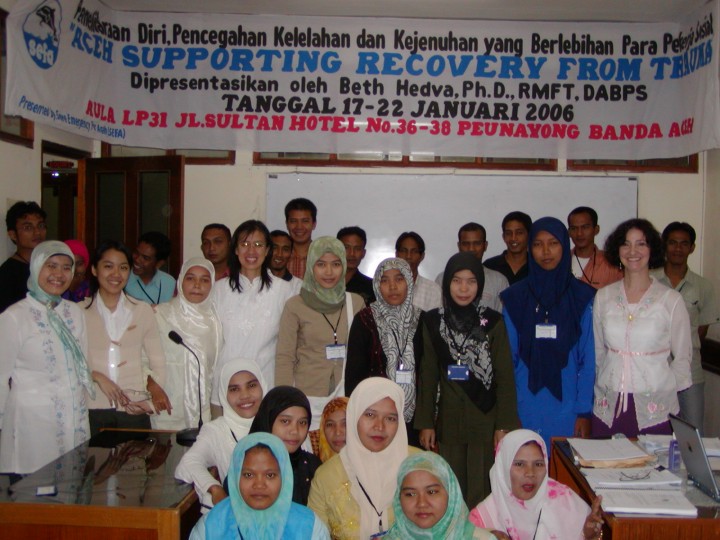
|
Training Front Line Counsellors In reponse to the massive December 26, 2004 tsunami, requests came for Dr Beth Hedva to create and provide a cross-cultural and transpersonal counselling approach that would be appropriate to the situation and cultures. (Indonesia has 200 million people on over 3000 islands speaking 250 dialects. The population is over 90% Muslim.) The requests for her services came from: The Indonesian Psychological Association, Tarumanagara University, Jakarta, and University of Indonesia, Jakarta. Later, additional requests came from: Atma Jaya University, Jakarta, Save Emergency for Aceh, Banda Aceh, |
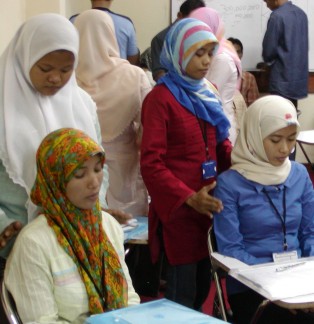
|
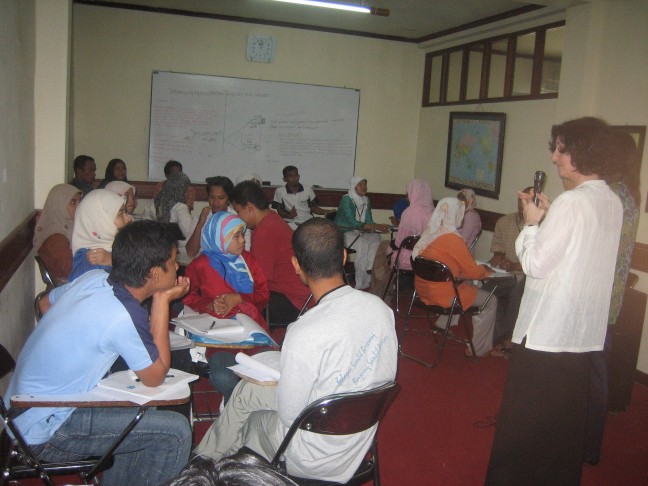
|
Working
with energy
Working in groups
Training the Front Line Counsellors Dr. Hedva was called because she is Chair of Continuing Education for the International Council of Psycholoigists and an authority on advanced counselling techniques. Others who assisted in first two trips: Travel: CATHAY PACIFIC Hong Kong LYNN HARRISON Canmore, Canada Publishing Costs (for the follow-up text): TALISMAN ENERGY Calgary, Canada |
Request for FIRST VISIT and Training
from TARUMANAGARA UNIVERSITY
View request for second visit and Training Program
from SEFA -- SAVE EMERGENCY FOR ACEH
Press Releases
Dr. Hedva followed through on the first request, providing programs at two universities in the capital of Jakarta -- the University of Indonesia and Tarumanagara University.
Her training program included both a unique cross-cultural counselling approach and effective counsellor self-care exercises. They were so successful that she received numerous requests to return to the hardest hit area, the city of Banda Aceh where more than 170,000 were confirmed dead: two thirds of all lives lost to the tsunami in all nations combined.
In the province of Aceh more than 600 clinics and hospitals were destroyed along with over 2,000 schools. Another 40,000 Acehenese are still missing.
The photos on this page were taken during the counselling program in Banda Aceh.
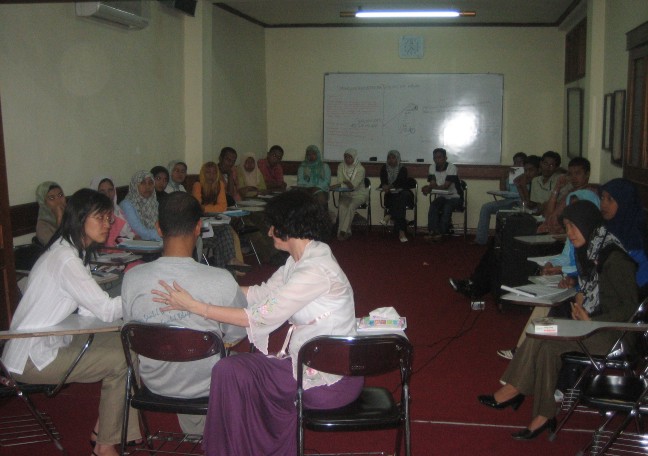
Beth Hedva Teaching Transpersonal Counselling and Healing approaches
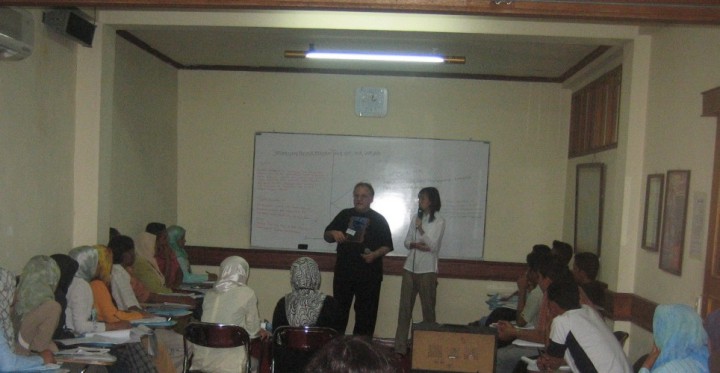
Harold Finkleman with Lisa Arman translating
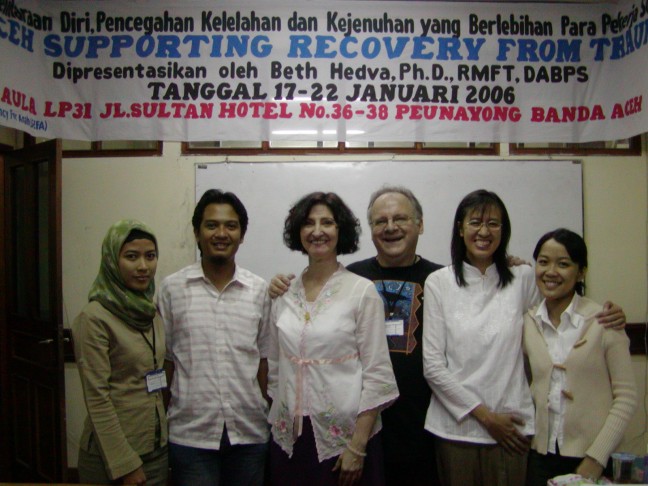
Alina and Yuli Zuardi Rais (he’s president of SEFA, the host NGO);
Beth Hedva and Harold Finkleman;
Lisa Arman, co-facilitating psychologist and translator from Atma Jaya University in Jakarta;
and translator/psychology-student Wuri, also from Atma Jaya.
Dr. Hedva is now working with Harold Finkleman to publish a trauma counselling manual in English and Indonesian. |
She has been asked to return and train more counsellors.
The first follow-up report:
A YEAR
AFTER THE TSUNAMI:
TRAUMA RECOVERY TRAININGS IN INDONESIA
TRAUMA RECOVERY TRAININGS IN INDONESIA
Beth
Hedva, Ph.D., RMFT, DABPS,
Chair of Continuing Education, International Council of Psychologists;
Global Program Faculty, Institute of Transpersonal Psychology,
Calgary, AB, Canada;
with
Elisabeth Arman, Psi.,
Psychology Faculty, Catholic University of Atma Jaya, Jakarta, Indonesia;
and
Harold Finkleman, ICIM,
Finkleman Communications Ltd. Calgary, AB, Canada
Chair of Continuing Education, International Council of Psychologists;
Global Program Faculty, Institute of Transpersonal Psychology,
Calgary, AB, Canada;
with
Elisabeth Arman, Psi.,
Psychology Faculty, Catholic University of Atma Jaya, Jakarta, Indonesia;
and
Harold Finkleman, ICIM,
Finkleman Communications Ltd. Calgary, AB, Canada
The extent of trauma encountered by victims of the south Asian tsunami has helped to expose both the need for and the success of integrating spirituality and intuition into western clinical psychology. It has also resulted in a reasonably large scale opportunity to examine the capacity of helping professionals to learn and utilize counselling approaches that bring those often contrasting (spiritual/clinical) worlds together.
It was in the cross cultural environment of Indonesia – a string of 3000 tropical, mountainous and volcanic islands with a culturally diverse population of 200 million people speaking 250 languages and dialects – where some of the limitations of contemporary western psychology were confronted. Spiritual practices – both modern and ancient – presented themselves as natural opportunities for helping victims to deal with many issues.
It is both because of the scale of the trauma and the desire to deal with the spiritual dimensions, that the Indonesian Psychology Association and Dr. Monty Satiadharma of Tarumanegara University invited me January 2005 to enhance and up-grade the training of psychologists working with survivors in Aceh.
The devastated province of Aceh is located in the northwestern tip of Indonesia’s island of Sumatra. Of the 225,000 who died throughout Southeast Asia from the tsunami, over 170,000 of them perished there -- mostly in the city of Banda Aceh -- along with the destruction of 690 hospitals and health clinics, 2,135 schools and universities, thousands of miles of roads, bridges, and houses. It was all washed away, leaving over 550,000 refugees stranded, far from help and far from media exposure and far from safety of almost any kind, due to an ongoing civil war.
In April 2005, I held the first series of classes for training at Tarumanegara University and the University of Indonesia, both in Indonesisa’s capitol, Jakarta, on the island of Java, immediately east of the island of Aceh. (In 2001 I had taught 5 half-day workshops at Tarumanagara for students, faculty and members of the Indonesian counselling community, mostly on a variety of transpersonal techniques,) I had hoped to be doing the training in Aceh, but there were no facilities as the region was only newly torn apart and, of course, the 30-year civil war was still brewing.
One of the psychologists who took the training in Jakarta was Lisa Arman, a member of the Faculty of Psychology at Atma Jaya University. She played the key role in bringing me back on the anniversary of the disaster. Lisa has been busy working as a recovery worker with Peduli Aceh, an Atma Jaya program in cooperation with SEFA, a well established Achenese NGO (non-governmental organization) that had been offering emergency services to orphans and victims of the civil war for many years and extended their role immediately to support victims of the tsunami.
With the persistence of Lisa Arman and the help of the Chief of SEFA, Yuli Zuardi Rais, I returned to Indonesia January 2006 with Harold Finkleman, a research journalist and lecturer on communication psychology and human response. We were taken directly to what had been the hardest hit area, the city on the westernmost tip of the island: Banda Aceh.
TRAUMA RECOVERY IN ACEH
The population in Aceh is recovering from double trauma. In addition to the 170,000 lost to the tsunami there are also casualties from 30 years of civil war and conflict between the Indonesian Government’s TNI (Military Police and army troops), and the GAM rebels (“Free Aceh Movement”). To date, the military conflict has cost more than 35,000 lives — that’s about three killed every day of every week of every month for three decades: Achenese civilians, including women and children.
We arrived in Banda Aceh January 17th just a couple of weeks after the GAM rebels had turned over their stockpile of 840 weapons, in exchange for the departure of a total of 32,000 Indonesian Military TNI.
With the help of SEFA, Harold and Lisa, who acted both as a translator and a co-facilitator, I conducted a 5 ½ day training for participants from eight different local Muslim NGO’s.
The participants were all helping professionals and university students -- social workers, counsellors, teachers, psychologists and recovery workers -- mostly between the ages of 20 and 30 years old.
Each of the participants were, themselves, victims and survivors of tsunami trauma. And each was born into an Aceh that was in conflict with the Indonesian Government, especially since its imposition of various forms of martial law throughout the end of the 20th century. It seems like no one in Ache was untouched by the trauma or stress of politics and unrest.
SPIRITUALLY DIRECTED THERAPY: TREATMENT AND PROTOCOL FOR SUPPORTING RECOVERY IN ACEH
Aceh is 98% ‘Fundamentalist’ Muslim (i.e. Orthodox) blended together with a strong mystical indigenous cultural tradition. A deep spiritual foundation is integrated into every aspect of life. Under normal circumstances, the local population might turn to prayer and reading the Koran, or to a beloved spiritual leader, an Imam, cleric, indigenous healer, astrologer or possibly a palmist long before they would consider seeking psychotherapy.
Because transpersonal approaches relate to each individual’s unique spiritual resources and mind-body-spirit experience, it was possible that religion might become an issue of conflict during our training. In fact, minds opened quickly and the transpersonal approach went over well after a few days of study and practice.
Conventionally, the current treatments of choice coming out of North America are medication management and cognitive-behavioral models, including relaxation techniques, breath retraining, and exposure therapy (a form of classical desensitization), combined with psycho-social interventions and play-therapy for children.
The program I developed included conventional psychological practices in tandem with Eastern healing practices and contemporary transpersonal approaches including:
- breathing practices,
- body awareness,
- energy work,
- mindfulness meditation, dream incubation and prayer,
- visualization and symbolic process
Trainees learned to distinguish cognitive thoughts from emotional feelings, from physical sensations (i.e. proprioceptive ‘feelings’) and from intuitive perceptions (i.e. subtle energy ‘feelings’ and symbolic awareness).
In addition to addressing clinical concerns for children and adult survivors, we also explored burn-out prevention for recovery workers and survivor guilt — the belief that one should have thought, felt or acted differently at the time of the disaster. Spiritually Directed Treatment Methods to intuitively respond to paranormal aspects of disaster trauma, like spirit communication, possession and or ghosts, were also discussed. These are significant concerns to many in South East Asia.
Participants practiced using intuition to gain insights that provided greater understanding, including compassion for oneself and others.
Stages of recovery were defined within the context of ancient and indigenous cultural Rites of Passage. Cross-culturally, rites of passage are designed to move individuals through an experience of what we might call ‘soul-death’, and into a personal ‘spiritual rebirth’ that fosters community renewal. In this model, participants learned how to pass through five distinct stages of recovery: responding to separation, emotional (and/or physical) ordeals, death, new knowledge, and symbolic rebirth or self-renewal .
We learn that in rites of passage, death – symbolic or real -- includes letting go of dysfunctional reactions or old coping mechanisms, fear, loneliness, worry, helplessness, etc. Death means grieving the loss of ways of life that may have been either tragically shattered or even symbolically destroyed—whether by tsunami, political conflict or both.
PROCESS AND OUTCOMES
Participants (each with significant experience already) learned and practised a range of leadership skills, including group facilitation and communication skills, along with exercising mental focus, breath-work, energy-awareness and intuition to make better use of their mental, emotional and spiritual resources. They learned how to tap into or ‘awaken’ their own inner resources such as inner strength, wholeness, faith and courage to help themselves and others at different stages of recovery from trauma.
I quickly saw that participants were genuinely personally motivated to heal and help others heal from trauma. As the training progressed, they became more enthusiastic about self-healing practices, as well as working with each other.
By the end of the program, each of the participants would report over-all relief from what had been their own symptoms associated with traumatic loss.
By the last day of the training, participants reported and described their success practicing spiritually directed therapy techniques with people outside the training group, with family members and friends.
And, before I left Indonesia in February, I had reports of participants successfully training co-workers as well as children, and other survivors whom they serve, in these methods.
The fact that these healing techniques were carried forward to others so quickly is not surprising in this case, for several reasons.
- First, this was a training for recovery workers, and they are in the role of helping others.
- Secondly, the methods introduced honored and incorporated both Islamic mystical traditions and Indigenous spiritual healing practices of the Achenese culture, which made it easy to carry into the community and into indigenous institutions.
- Finally (and I have found in my clinical practice generally), those who find their way through and beyond the experience of trauma, even those who are not trained in the field, tend to want to share what they have learned, and often have a desire to help others avoid the same extremes of trauma.
In this way individual recovery becomes the foundation of community renewal.
ASSESSMENT OF SPIRITUALLY DIRECTED TREATMENT OUTCOMES
Beyond the immediate relief for participants and their community (as described above), the success of this training program is yet to be fully evaluated. To ascertain the effectiveness of the program we titled Spiritually Directed Treatment and Protocol, I handed out a ‘symptoms checklist’ on both the first and last day of the training.
The self-assessment check list offered DSM IV symptoms for depression and anxiety, including acute and post-traumatic stress indicators across six (6) dimensions: 1) Anxiety, 2) Motor Tension, 3) Autonomic Hyperactivity, 4) Apprehensive Expectation 5) Vigilance and Scanning 6) Disturbance/Mood/Affect (depression and guilt).
Likewise, my co-facilitator, Lisa Arman solicited another symptoms-checklist post-test as a follow-up to our January training, which she will hold with the same group of participants.
The initial results of my training program in Spiritually Directed Therapy and Protocol for Supporting Recovery from Trauma, as indicated by review of the self-assessment Pre-Post Test Symptom Checklist, are as follows:
- Over-all, the mean score on each of the six (6) dimensions are lower in the Post-test, except for Vigilance and Scanning, which was higher for Male Participants in the post-test.
- A t-test statistical analysis indicated significant gender differences between male and female participants.
- Male participants self-assessment indicates some decreases in symptoms of Anxiety, Motor Tension and Autonomic Hyper Activity-though these decreases are not statistically significant. There are also insignificant increases in symptoms of Apprehensive Expectations and Disturbance Mood Affect. Finally, ‘Vigilance and Scanning’ symptoms increased significantly on the men’s post-test.
- Female participants self-report showed a decrease in symptomology along all dimensions, and a statistically significant decrease along three dimensions: Motor Tension, Autonomic Hyperactivity, and Disturbance Mood Affect. The biggest decrease is in Autonomic Hyperactivity, followed by Disturbance Mood Affect, and then Motor Tension.
While a review of the literature is beyond the scope of this brief article, suffice it to say that gender differences are not uncommon when dealing with grief and loss. Women in Aceh, as in many cultures around the world, have more permission to feel and express feelings. Added to this social more, is the Asian cultural ‘loosing face,’ in which direct public confrontation of another, and expressions of discomforting emotions is taboo and may invoke strong feelings of shame. Plus the fact that Aceh, historically, is a proud, independent culture whose warriors never fully complied with Dutch imperialism, and cost the Dutch10,000 lives when they attempted to colonize Aceh. These social conditions, along with 30 years of conflict with the Indonesian government, contribute to a perpetuation of the ‘warrior role’ for men in which grief and tears are indicators of vulnerability.
Hence, permission to grieve openly in the training, (ranging from acknowledgement of losses to shedding tears publicly), a year after the trauma, would have impacted the men in the group differently than women. Women would feel greater relief that comes with congruence between inner experience and authentic self-expression. And, contradictory feelings like relief and discomfort (from breaking social and cultural taboos) perhaps confounded men, leading to mixed results.
In mystical traditions world-wide, moving out of the comfort of one’s known or comfortable roles evokes an existential ‘soul death’ that initiates spiritual transformation and self-renewal. It would be interesting to research whether breaking through social conditioning and taboos about expressing emotional vulnerability is a necessary step for full recovery from loss and trauma cross-culturally. In other words, is acceptance of the existential experience of human vulnerabilities a universal factor in healing --independent of culture -- and might this be the heart of what affords a shift in consciousness that awakens the transformative potential latent in healing from trauma.
Perhaps, instead of merely ‘coping’ with loss, this transpersonal approach towards self-renewal may have trained participants to begin the process of transformative healing. To help themselves and others move beyond their fears into feeling greater equanimity in the face of on-going uncertainty. (Whether uncertainty is due to fear of loss of identity, i.e. ego-death through breaking down social taboos. Or fear of physical death that is very real when living in a volatile geo-physical environment, with frequent earthquakes and volcanic activity that could activate another tsunami. Or fear of torture and human rights violations due to an unstable political environment.)
Results from the May post-test will give greater insights into the effectiveness of this training model over time. Harold Finkleman and I intend to return to do a follow-up training with Lisa Arman for SEFA in Banda Aceh. The follow-up will focus even more on the impact of the conflict trauma, with a focus on the promotion of both inner peace and social transformation.
NEXT STEPS FOR INTERNATIONAL DISASTER RESPONSE, RECOVERY FROM TRAUMA, AND WORLD MENTAL HEALTH
The tsunami that started just off the coast of Aceh, stretched across the Indian Ocean from Indonesia and Thailand all the way to the shores of Africa, and claimed the lives of citizens from 12 nations across the globe. Whether it is the tsunami in Asia, hurricane Katrina in the Southern US, or the earthquake in Pakistan, people who face sudden and sever loss share common trauma pathology, and recovery volunteers need more than good counselling programs, they need coaching on self-care and burn-out prevention.
There is a universal humanitarian element that runs through all disasters. We are dependent upon one another and nature. Disasters invite humanity to cross the usual social, economic or political divides, and to share resources—reminding each other of even deeper truths—there is unity amidst diversity, and we are not alone in time of need.
The influx of foreign aid including foreign visitors and media attention all impacted the situation. The combination of emergency conditions that required cooperation between the Indonesian Government, foreign aid and both foreign and local rescue workers, victims and survivors all contributed to the establishment of new protocols, successful peace negotiations in Finland and more respectful relations between the Acehnese, the Indonesian Government and the world community.
Each time before I left to work in Indonesia, I had the good fortune to participate in ceremony with friends and colleagues, including North American Aboriginal Elders, to help prepare me for my journey. Aboriginal peoples from the Americas teach that the shorelines are the lips of the Earth Mother, and that natural disasters, like tsunami are Mother Nature’s way of communicating to us, and helping us to restore harmony and balance to life on Earth. In the case of Aceh, the tsunami paved the way for peace, after 30 years of civil war by bringing international attention to a disenfranchised part of the world community.
Three-quarters of the world's population in our emerging global community are from Asia and Africa; and like indigenous cultures in the Americas, these populations integrate intuition and spirituality into the fabric of daily life. World Psychology means beginning the conversation of
1) how we might better respect the contributions of non-Western cultures and their spiritual healing traditions to World Mental Health.
2) limitations of exporting North American or Western versions of ‘mental health’ around the world,
3) Western cultural dominance (embedded in our academic training bias) as a form of psychological imperialism, and
4) transpersonal psychology, which includes spirituality, as a potential bridge.
Experiences with the Indonesian Psychology Association, Tarumanegara University, Atma Jaya and the University of Indonesia make it easy to envision some of the next steps in the field of psychology to include building bridges of collegiality and information exchange between developing nations and more developed nations in support of advancing world psychology in honor of the wisdom and special needs of our multi-cultural global community.
Though much of Western psychology tends to focus on psychopathology, what is also true is that some of us, in the face of disaster, do not regress, but actually progress and demonstrate even greater strength, compassion and goodwill. We can each learn to awaken these natural and innate capacities within our being to help ourselves and others in times of need. Likewise, further research into integrative training approaches to community mental health may be required to determine methods that offer genuine and respectful cross-cultural approaches to community wellness and individual mental health.
Original requests from Indonesia responding to needs
after the loss of more than 170,000 lives in Aceh:
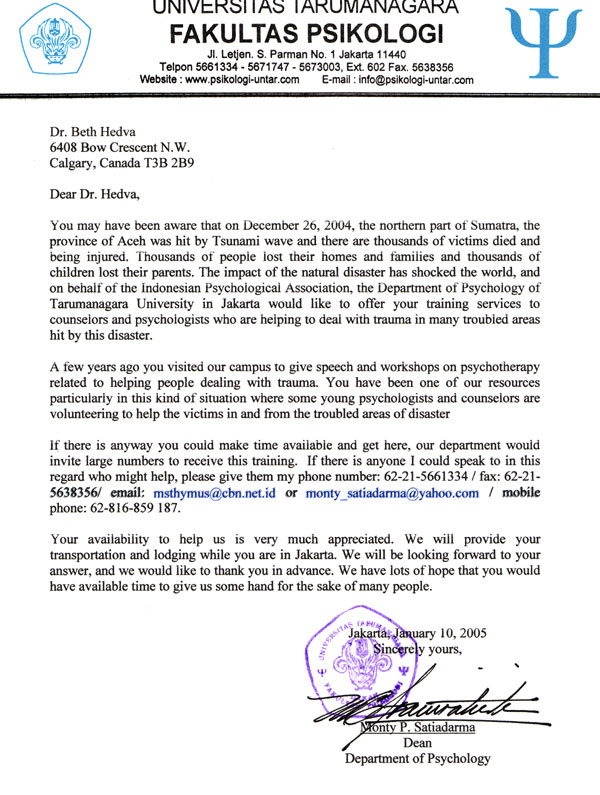
Request for further support in Aceh
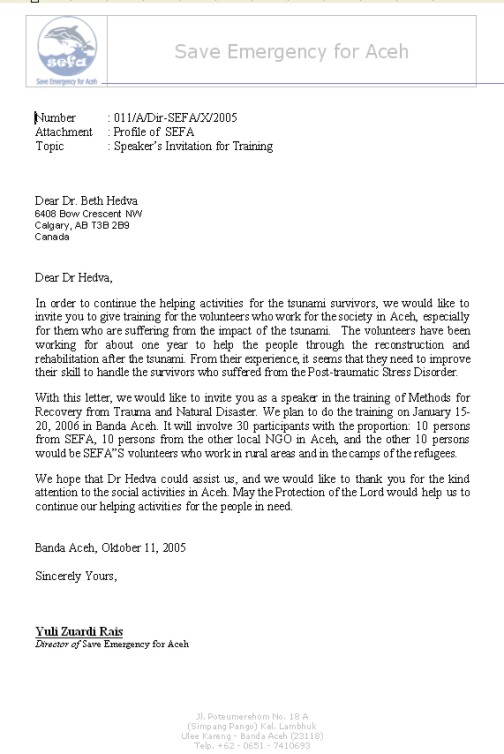
this follow-up letter was
for individuals supporting SEFA's efforts
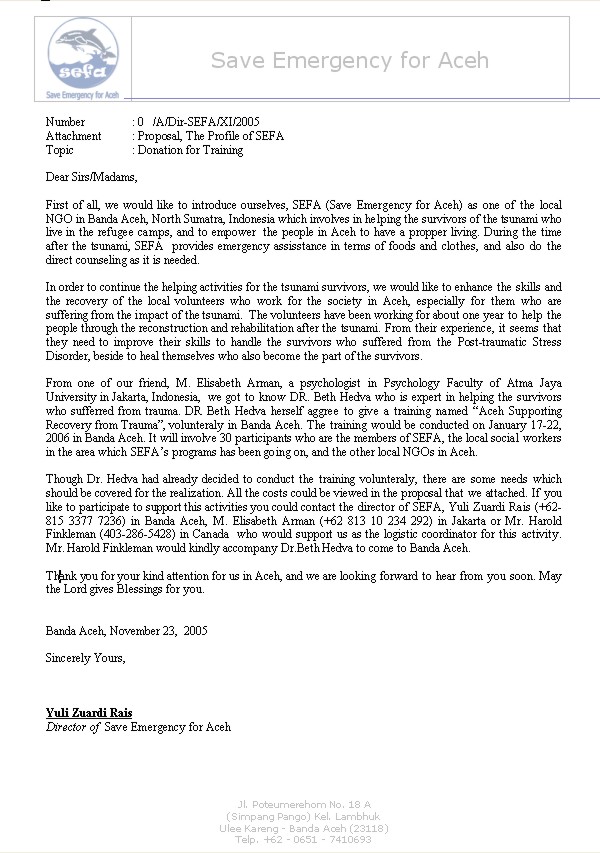
| (the following is a copy of a media release early 2005) |
MEDIA RELEASE
for immediate release
In response to the extensive loss of lives in the recent Tsunami, a resident of Calgary, Canada has been selected by the Indonesian Psychology Association to train that nation's psychology community in the latest techniques in healing the victims of the grief and trauma.
A request came from the Indonesian Psychology Association and Tarumanagara University in Jakarta Indonesia earlier this year for Dr. Beth Hedva to train “counselors and psychologists who are helping to deal with trauma in many troubled areas hit by this disaster.”
Cathay Pacific has volunteered to fly Dr. Hedva to and from Jakarta, while the university will care for her food, accommodation and security while she is there. Though the association and university offered to pay her, she has donated her time and asked that the budgeted money be spent on other relief efforts. Her lectures will be simultaneously translated, recorded and published in local dialects for those counselors who will be unable to attend.
Dr. Hedva is the author of Betrayal, Trust and Forgiveness – a book which combines clinical psychology and transpersonal psychology with cross-cultural traditions to initiate new approaches in dealing with life’s traumas. The traumas or “betrayal issues” dealt with in her book range from divorce, job loss and death in the family to the betrayal of family members, government or even nature.
A counsellor in private practice in Calgary, she is currently Chair of Continuing Education for the International Council of Psychologists and lectures world-wide. Dr Hedva has a Masters Degree in Clinical Psychology, a Masters Degree in Transpersonal Psychology and a Doctorate in Psychology. She moved from the San Francisco Bay area to Calgary in 1995 to marry her partner, another researcher and lecturer on the global circuit.
Dr. Hedva leaves for Jakarta Sunday afternoon (April 3rd, 2005).
-- end --
for further information contact:
Dr Monty Satiadarma (Tarumanagara University)
001-62-21-566-1334 or 001-62-21-567-3003 (Ext 602)
Dr. Beth Hedva: (403) 247-1441 Harold Finkleman (403) 286-5428 or visit: http://www.hedva.com |
